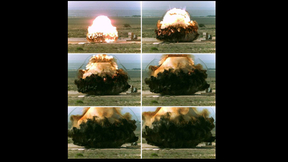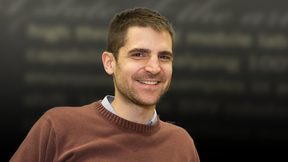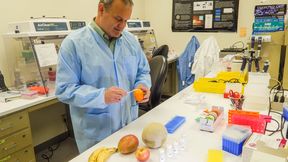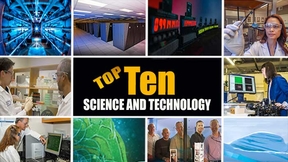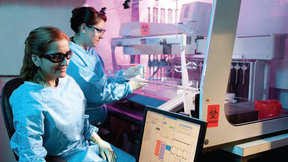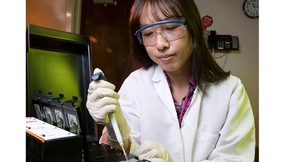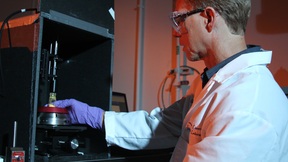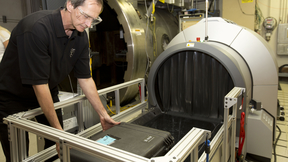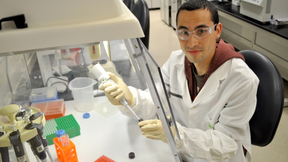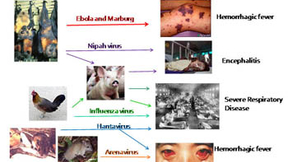Back
Threat preparedness
Lawrence Livermore researchers use seismic signals to track above-ground explosions
Lawrence Livermore researchers have determined that a tunnel bomb explosion by Syrian rebels was less than 60 tons as claimed by sources.Using seismic stations in Turkey, Livermore scientists Michael Pasyanos and Sean Ford created a method to determine source characteristics of near-earth surface explosions. They found the above-ground tunnel bomb blast under the Wadi al…
Lawrence Livermore technology could help detect diseases in commercial swine industry
Agricultural officials who seek to detect diseases affecting the commercial swine industry may gain a new ally — a biological detection system developed by Lawrence Livermore National Laboratory (LLNL) researchers.A study by LLNL and Kansas State University scientists found that the Lawrence Livermore Microbial Detection Array (LLMDA) could help identify diseases in the…
The accidental entrepreneur
Editor's note: This article is part of an occasional series about LLNL entrepreneurs_______________Martin Casado considers himself to be an accidental entrepreneur.The 38-year-old Bay Area tech executive went from a research career at Lawrence Livermore National Laboratory to a doctorate at Stanford University, to starting and selling a company and finally to his current…
Lab's Jeff Drocco named Biosecurity Fellow
A spring workshop in the nation’s capital earlier this month provided an auspicious start for LLNL’s Jeff Drocco and other participants in the Emerging Leaders in Biosecurity Initiative program.Drocco is one of 28 fellows — selected from nearly 100 applicants — participating in the program at the Center for Biosecurity, which is operated by the University of Pittsburgh’s…
Providing data for nuclear detectives
Fans of the popular TV series "CSI" know that the forensics experts who investigate crime scenes are looking for answers to three key questions: "Who did it; how did they do it; and can we stop them from doing it again?"The field of nuclear forensics, an important element of LLNL’s national security mission, has similar goals and uses similar techniques — but with even…
Technology quickly traces source of tainted food
LIVERMORE, California – Foodborne illnesses kill roughly 3,000 Americans each year and about 1 in 6 are sickened, according to the Centers for Disease Control and Prevention. Yet most contaminated foods are never traced back to their source. That’s because existing methods to track tainted food following its supply chain from table to farm are highly inefficient,…
Top 10 science and technology stories of 2014
In 2014, Lawrence Livermore National Laboratory (LLNL) built on a 62-year tradition of translating basic science into technologies that ensure national security, address pressing real world problems and expand the boundaries of fundamental science.The top stories of the year are a reflection of the Laboratory’s ability to apply its core national security competencies to a…
White captures second award for nuclear forensics work
For the second time, Lab physicist Roger White, a designer in B-Division from the Weapons and Complex Integration (WCI) Directorate, has received an award from the Defense Threat Reduction Agency (DTRA) for his work in post-detonation nuclear forensics.White was named the "top contributor of the quarter" for the third quarter of the fiscal year 2013 (April-June, 2013) for…
Lawrence Livermore researchers unveil carbon nanotube jungles to better detect molecules
LIVERMORE, Calif. - Researchers from Lawrence Livermore National Laboratory (LLNL) and the Swiss Federal Institute of Technology (ETH) in Zurich have developed a new method of using nanotubes to detect molecules at extremely low concentrations enabling trace detection of biological threats, explosives and drugs. The joint research team, led by LLNL Engineer Tiziana Bond…
LLNL wins four tech transfer regional awards
Lawrence Livermore National Laboratory (LLNL) has again received recognition this year for its work to move breakthrough technologies into the commercial marketplace.Livermore researchers and tech transfer professionals garnered four awards in the Federal Laboratory Consortium's (FLC) Far West Regional competition.This year's awards, presented last week during the FLC's…
Bio celebrates 50th Anniversary
Over the last 50 years, scientists from Lawrence Livermore National Laboratory's (LLNL) Biosciences and Biotechnology Division (BBTD) have changed the world by being instrumental researchers on the Human Genome Project, developing high-tech devices to sort cells and analyze DNA and providing the science for federal programs to defend the nation from biological weapons…
LLNL scientists pioneer the use of established technology for analyzing uranium ore concentrate samples
A team of Lawrence Livermore National Laboratory (LLNL) researchers has pioneered the use of a long-standing technology for a new application -- analyzing the chemical composition of uranium samples.In a paper published as the cover story in the September edition of Applied Spectroscopy , the Laboratory scientists describe the first reported use of near-infrared…
Association between virus, bladder cancers detected using Lawrence Livermore technology
A Lawrence Livermore National Laboratory (LLNL)-developed biological detection technology has been employed as part of an international collaboration that has detected a virus in bladder cancers.The research, performed in conjunction with scientists from the University of Split in Croatia, LLNL and the University of Jordan in Amman is believed to be the first study to…
Lab researcher Harry Martz makes flying safer for Americans
Each time you step on a commercial flight, you can feel safer because of a researcher you've probably never heard of. His name is Harry Martz. He's a veteran scientist at the Lawrence Livermore National Laboratory (LLNL) who wakes up every day thinking how his research can advance X-ray imaging technology to thwart the next terrorist attack. See the video .Plainspoken and…
Lawrence Livermore scientists make new discoveries in the transmission of viruses between animals and humans
Outbreaks such as the severe acute respiratory syndrome (SARS) and Middle East respiratory syndrome coronavirus (MERS) have afflicted people around the world, yet many people think these trends are on the decline.Quite the opposite is true.The efforts to combat this epidemic are being spearheaded by a team of Lawrence Livermore National Laboratory (LLNL) scientists. Led by…
DHS intern helps develop portable virus detection
When Cesar Ambriz's father discovered a tomato-farming job in northern California, he and his family left their relatives and crossed the Mexican border to establish a life ripe with promise. "In Mexico it's really tough for anyone to go to college, especially to get financial aid. It's a challenge if you don't have money," Ambriz says. After obtaining a high GPA and…
Lab bioscientist looks into origin of viruses
Monica Borucki, a scientist in the Lab's Biosciences and Biotechnology Division has won a 1-year contract from the Defense Threat Reduction Agency. The $415,000 contract will fund a research project staffed by a team of six Lab scientists that will study how to better determine the origin of a virus. Knowing the origin of a virus is important in a public health emergency…
Lab team wins poster award for virus research
A team of Lab researchers may be able to use rare mutations from the virus population of an animal host to distinguish between samples that previously appeared to be genetically identical. Their work, done in collaboration with a researcher from the Richmond-based California Department of Public Health, won one of three outstanding poster awards at a Defense Threat…


